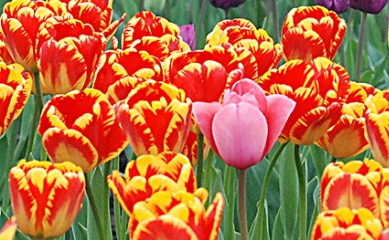I spent the afternoon today at the BYGL Diagnostic Walk at the Cincinnati Zoo and Botanical gardens, which to us in the horticultural world passionately refer to it as the Cincinnati “Botanical Gardens and Zoo”. Our host today was Steve Foltz, who is the Director of Horticulture at the Cincinnati Zoo and a highly knowledgeable horticulturist. There is a great deal of activity abuzz on the grounds these days, all of the new annual beds are being amended and planted. Steve referred to the Zoo as a, “giant container planter”, this he explained is because of all of the concrete that makes up the Zoo exhibits with small plots of soil here and there. If you have ever been to the Zoo you would know about the world class displays that can be found all over the Zoo grounds. It begins in April with Zoo Blooms. If you have not experienced this event then you are missing out on the vibrant palette of colors of 100,000 tulips amassed throughout the zoo grounds.
As the month of May is ushered in all of the tulips are dug up and the beds are prepared for annuals to take over the landscape. The Cincinnati Zoo prepares all of their bed with a blend of pine fines and peat for the best results. They find that this mix gives the soils the ability to drain off quickly, which is important to be able to work the soils and get all of the plants into the ground as quickly as possible. Steve shared some of the challenges at the Zoo such as, the Lions in the African Savanna exhibit having the need to mark there territory on the trunk of trees in the display with his sharp claws. Then there are the giraffe that can pick the trees clean of their leaves. It’s not just the animals that are horticultural challenges, but Zoo visitors are challenges too. Steve showed us how the Zoo protects the visitors from getting to close to dangerous animals with fences that have to be masked with dense shrubs and bamboo to maintain the experience each exhibit is designed to represent.
The Cincinnati Zoo and Botanical Gardens isn’t just a place of beauty and wildlife, but an example of sustainability and green stewardship. As you arrive at the Zoo it’s hard to miss the massive series of solar arrays that cover the parking lot. This structure not only provides shade for the cars that park below them, but provide about 20 percent of the zoo’s electrical needs. You can also find other examples of green living such as waterless urinals in the men’s restrooms, there are pervious pavers laid as walkways that allow storm water to drain thru them and into a huge tank that is used in exhibits on the Zoo grounds. Did I mention that they have examples of green roofs on several of the buildings. In addition to these examples, the Zoo also has a trial program that rates plants according to how well they perform in the Greater Cincinnati region. This allow them to grow plants that do well, and eliminate plants that are not suitable for this area. All of this information is available to the public on http://www.plantplaces.com and is given out during sustainable symposiums held at the Zoo. If you want to learn more about being green in Cincinnati the Zoo is a great place to start, and did I mention they have world class animal displays too?
~ Michael

